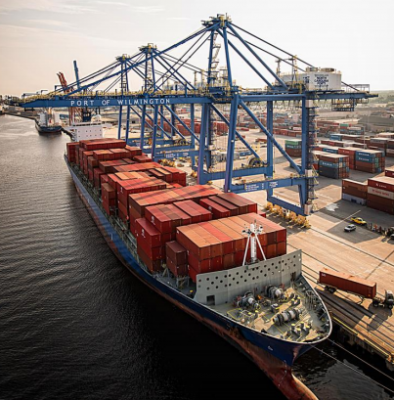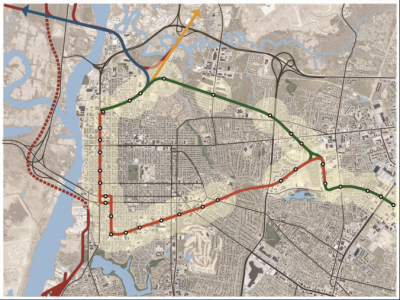WILMINGTON – Last year when the House Select Committee on Strategic Transportation Planning and Long Term Funding Solutions took a trip to the coast, members scouted the clogged New River Inlet on shallow-draft shrimp trawlers. For this year’s visit, the vessels encountered were considerably larger.

On Monday, the committee, which reviews legislative needs for large-scale transportation projects, toured the North Carolina Port of Wilmington to review its recent resurgence in shipping, ongoing upgrades and a long-range list of spending priorities.
Supporter Spotlight
Topping the list is a request for state backing of a major freight rail realignment that both city and ports officials say will allow the port to grow and transform regional transportation for the fast-growing area.
Glenn Harbeck, the city’s director of planning, development and transportation, said that with growth projections for the region showing a population of 700,000 by 2040, there has to be a way for the port’s growth not to lead to gridlock. The question, he told legislators, is “how can the port be successful without killing the goose that laid the golden egg, without traffic coming to a grinding halt?”
The centerpiece of the proposed solution would be a rail line that moves freight service to the port to the west side of the Cape Fear River, running parallel to a portion U.S. 421. The 5-mile route would be 3 miles shorter than the current 8-mile route through Wilmington, but more importantly it would eliminate 32 at-grade rail crossings in the city.
Harbeck said that becomes critical going forward for two main reasons: An increase in rail activity at the port means longer trains and longer wait times at crossings along the city’s main traffic corridors as a result, and keeping the rail line through town means elevating the city’s proposed extension of Independence Boulevard, a major north-south route. The city and the state have been at odds over the project after Wilmington officials rejected a North Carolina Department of Transportation proposal that required the road to be built on a 30-foot-high berm to avoid rail crossings. Without that requirement, Harbeck said, the boulevard project would cost $75 million less and not bisect the city with an elevated four-lane street.

A second phase of the project would then repurpose the former rail route through town for either a greenway or a trolley system to move people in and out of downtown.
Supporter Spotlight
“This is not a project for tomorrow. It’s not a project for next year,” he said, “but it is a project that we all should be keeping in mind.”
Laura Padgett, chair of Wilmington’s rail realignment task force, said the proposed rail route is currently being reviewed for potential environmental effects. About a third of the route would run along a raised former rail bed, which should reduce some of the impacts, she said.
Mike Giles, a coastal advocate with the North Carolina Coastal Federation, said there are wetland and stream crossings along the route that would need to be thoroughly reviewed, but moving the rail line would likely have a positive effect on the environment, as well as reducing traffic congestion, truck traffic and the vehicles idling at rail crossings.
“It does make sense to move that industrial use out of the middle of the city,” he said in a recent interview.
Not Cheap
The cost of any rail realignment starts out approaching the $1 billion mark, with estimates for the main bridge over the Cape Fear at $350 million and a shorter bridge over a channel on the west side of the river at $260 million.

But so far legislators haven’t balked at the price tag.
“They’re big numbers, but they’re all big numbers these days,” Rep. John Torbett, R-Gaston, who chairs the select committee, said after the ports presentation. Torbett and Rep. Holly Grange, R-New Hanover, said one appeal of the project is being able to reduce the reliance on truck traffic by improving the rail link.
“It’s a no-brainer to me, because it will help reduce some of the truck traffic that now goes over the bridge,” Grange said. At the same time, she said, it will assist the port with a much-needed rail improvement.
“We’ve got to remain competitive and we’ve got to make the investment to do that,” Grange said.
Port officials say the rail realignment could assist in helping Wilmington’s port move goods inland.

Paul Cozza, executive director of the North Carolina Ports Authority, said use of a rail line to an inland port location near Charlotte has grown faster than predicted and underlined the need for improvements to rail service.
The port lost its intermodal rail facility about three decades ago, he said. Rebuilding intermodal capability, Cozza added, is one of the key ways Wilmington can stay competitive with other ports. About 30 percent of all container traffic on the East Coast moves inland by rail, and shippers want that option, he told legislators. If shipping companies see Wilmington as a truck-only facility, it makes it much harder to compete.
“We need to offer that to be able to grow,” he said.
Padgett, who has led the project since 2015, said Wednesday that she’s upbeat about legislators’ reaction to the plans, so far. She also expects to brief staff with 3rd District Congressman Walter Jones office in the next few weeks.
“Everybody has been very excited and interested in this,” she said. “It’s not cheap, but nothing worth doing is.”







